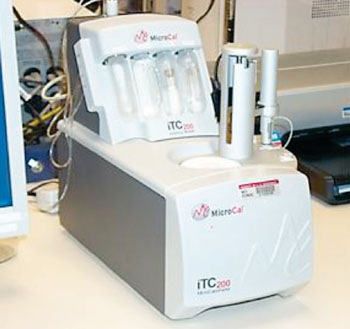New Tool Detects and Destroys Norovirus
By LabMedica International staff writers
Posted on 02 Apr 2015
Infection with highly contagious noroviruses, while not usually fatal, can lead to a slew of unpleasant symptoms such as excessive vomiting and diarrhea and current treatment options are limited to rehydration of the patient.Posted on 02 Apr 2015
A "nanobody" called Nano-85 has been discovered that was able to bind to intact Norovirus-like particles (VLPs) in culture; nanobodies are very similar to antibodies, which recognize and bind to antigens and Nano-85 was able to recognize the VLPs from a variety of different Norovirus strains.

Image: The iTC200 Isothermal Titration Calorimeter (MicroCal) (Photo courtesy of US National Institute of Health).
Scientists at the German Cancer Research Center (Heidelberg, Germany) tested the nanobody on stool samples from patients infected with the virus. In order to determine the potential of Nano-85 as a detection reagent for clinical specimens, 30 stool specimens from patients presenting sporadic gastroenteritis were screened using a modified sandwich enzyme-linked immunosorbent assay (ELISA). Twelve specimens were determined as GII.4 Norovirus positive using single-round reverse transcription-polymerase chain reaction (RT-PCR).
Isothermal titration calorimetry (ITC) studies were performed using a MicroCal iTC-200 calorimeter (GE Healthcare, Wauwatosa, WI, USA). A technique called X-ray crystallography was used determine the shape and molecular components of the Nano-85/P domain complex, as well as specific sites where Nano-85 and the P domain formed bonds. The investigators found that the site where Nano-85 bound to the P domain was actually hidden under the viral particle's surface.
Nano-85 was able to detect virus in one-third of the samples already known to be positive for noroviral ribonucleic acid (RNA). Nano-85 could detect the current pandemic GII.4 Norovirus virions in clinical stool specimens from patients with sporadic gastroenteritis using a sandwich ELISA format, although the detection rate was low. On the other hand, most ELISA detection kits currently are used for screening outbreak specimens and have low detection rates with sporadic specimen.
Grant S. Hansman, PhD, the lead author of the study said, “If Nano-85 is indeed causing intact VLPs to disassemble, this could be a very promising lead in developing Norovirus antiviral therapy. This could be especially beneficial to immunosuppressed individuals such as cancer patients. Administering a vaccine to protect against infection would overwhelm the patient's immune system. However, if he or she has the option of receiving an antiviral to eliminate the infection, the Norovirus becomes much less dangerous.” The study was published in the March 2015 issue of the Journal of Virology.
Related Links:
German Cancer Research Center
GE Healthcare













